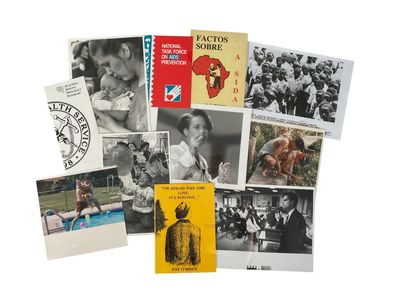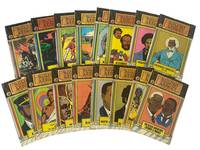first edition
by LGBTQ, AIDS Crisis
[LGBTQ] [Marginalized Groups] AIDS crisis archive archive of 11 photographs and documents addressing the AIDS epidemic, with a focus on pediatric care, LGBTQ+ communities, international education, and public health advocacy, 1988–1995. This group documents both government and grassroots responses to the crisis and includes visual and textual material highlighting Black, queer, and child-centered perspectives—an uncommon convergence in AIDS-related archives. Archive includes:
[1] Foster, Geoff. Factos Sobre a SIDA: 100 Perguntas e Respostas Sobre a Síndrome de Imunodeficiência Adquirida. Mutare, Zimbabwe: Family AIDS Caring Trust, June 1988. A 53-page educational booklet published in Portuguese for a Zimbabwean audience addressing fundamental questions about AIDS transmission, diagnosis, and stigma for African audiences. This booklet combines medical information with moral guidance and reflects the early effort to reach Lusophone African populations.
[2] Surgeon General’s Report on Acquired Immune Deficiency Syndrome. Washington, D.C.: U.S. Department of Health and Human Services, 1988. Issued under Surgeon General C. Everett Koop, this early federal publication marked a turning point in AIDS policy by urging compassion and scientific understanding over stigma. Koop’s signature appears in facsimile beneath a bold appeal: “We are fighting a disease, not people.” The report contextualizes projections for national case numbers and healthcare costs, calling on citizens to educate themselves.
[3] Press photo of a young boy at the Farono Center, a residential facility for children affected by HIV/AIDS, 1988. Photograph by Nicholas Liai. Press photograph with typed caption identifying the child as "Kenny", one of seven HIV-positive residents at the Farono Center in Albany. Reflects early infrastructure for long-term pediatric care in response to vertical HIV transmission.
[4] Press photo of a woman holding a baby at the Farono Center, 1988. Photograph by Nicholas Liai. Press photograph with typed caption reading "Gretchen, one of the people that care [for] children that [are] HIV positive holding Terrell, 9 mon." Farono Center. Albany. The image emphasizes the affective labor and caretaking networks central to pediatric AIDS care in the U.S. during the late 80s.
[5] O’Brien, Pat. “I’m Afraid This Time Love, It’s Positive…” London: The Oscars Press, 1989. First edition. A scarce collection of six AIDS-themed poems by a gay British writer, issued by a queer poetry collective to support day patients at Hammersmith GU Med. The text evokes mourning, love, and resilience. One of the earliest poetic responses to the epidemic published by and for the LGBTQ+ community in Britain.
[6] National Task Force on AIDS Prevention. San Francisco: ENE Advertising, ca. 1992. Eight-panel color brochure produced for Black gay and bisexual men. It outlines culturally specific “Hot, Horny & Healthy” workshops and discusses community-level data from a 950-person KAB study. Emphasizes peer-led condom use education and interactive roleplay in a harm reduction model. Designed by ENE Advertising, the piece exemplifies early tailored HIV interventions for marginalized communities.
[7] Press photograph of children orphaned by AIDS in Bukulula, Uganda, 1992. Photograph by Alexandra Avakian. New York: The New York Times Pictures, 1992. Silver gelatin press photograph showing children orphaned by AIDS in Uganda, taken by Avakian for a feature on the crisis’s impact across sub-Saharan Africa. The caption highlights the intergenerational and demographic devastation of the pandemic in the Global South. Fine.
[8] Press photograph of a camper and counselor at Camp Heartland, a program from children affected by HIV/AIDS, 1993. Photograph by Stormi Greener. Minneapolis: Star Tribune, August 31, 1993. Press photo showing one of the camp counselors carrying 10-year-old Rachael Davis into a swimming pool during summer activities at a camp for HIV-positive youth. With detailed typed caption and rubber stamp date.
[9] Press photograph of campers at Camp Heartland, 1993. Photograph by Stormi Greener. Minneapolis: Star Tribune, August 31, 1993. A second photograph from the same assignment, showing Rachael frog hunting with her brother Ajani, who attended camp to support her. Caption explains Ajani is not HIV-positive but has been emotionally affected by his sister's illness.
[10] Press photograph of HIV/AIDS education Jeff Hons giving a lecture, 1993. Photograph by Bob Owen. Jeff Hons Teaching HIV/AIDS Education at Neil Armstrong Elementary School. San Antonio: Express-News, February 5, 1993. Silver gelatin photograph of Hons, an educator with the Brady-Green Clinic, speaking to parents about sexual health curriculum. Reflects localized tensions over sex education in conservative American communities.
[11] Press photograph of AIDS activist Rae Lewis Thornton address the AIDS Summit in New Orleans, 1995. Phrograph by Ric Francis. New Orleans: Associated Press, June 30, 1995. Thornton, a nationally known activist and Black woman living with AIDS, is shown addressing social workers about stigma and sexual health in the Black community. Caption documents her status as a heterosexual woman who contracted HIV in her twenties. A rare visual artifact foregrounding Black women’s leadership in AIDS education.
Each item shows light handling or press file markings; overall very good to near fine condition. This is an unusually comprehensive AIDS archive centered on children, race, gender, and internationalism, offering primary source material for scholars of public health, queer history, and transnational activism. (Inventory #: 21770)
[1] Foster, Geoff. Factos Sobre a SIDA: 100 Perguntas e Respostas Sobre a Síndrome de Imunodeficiência Adquirida. Mutare, Zimbabwe: Family AIDS Caring Trust, June 1988. A 53-page educational booklet published in Portuguese for a Zimbabwean audience addressing fundamental questions about AIDS transmission, diagnosis, and stigma for African audiences. This booklet combines medical information with moral guidance and reflects the early effort to reach Lusophone African populations.
[2] Surgeon General’s Report on Acquired Immune Deficiency Syndrome. Washington, D.C.: U.S. Department of Health and Human Services, 1988. Issued under Surgeon General C. Everett Koop, this early federal publication marked a turning point in AIDS policy by urging compassion and scientific understanding over stigma. Koop’s signature appears in facsimile beneath a bold appeal: “We are fighting a disease, not people.” The report contextualizes projections for national case numbers and healthcare costs, calling on citizens to educate themselves.
[3] Press photo of a young boy at the Farono Center, a residential facility for children affected by HIV/AIDS, 1988. Photograph by Nicholas Liai. Press photograph with typed caption identifying the child as "Kenny", one of seven HIV-positive residents at the Farono Center in Albany. Reflects early infrastructure for long-term pediatric care in response to vertical HIV transmission.
[4] Press photo of a woman holding a baby at the Farono Center, 1988. Photograph by Nicholas Liai. Press photograph with typed caption reading "Gretchen, one of the people that care [for] children that [are] HIV positive holding Terrell, 9 mon." Farono Center. Albany. The image emphasizes the affective labor and caretaking networks central to pediatric AIDS care in the U.S. during the late 80s.
[5] O’Brien, Pat. “I’m Afraid This Time Love, It’s Positive…” London: The Oscars Press, 1989. First edition. A scarce collection of six AIDS-themed poems by a gay British writer, issued by a queer poetry collective to support day patients at Hammersmith GU Med. The text evokes mourning, love, and resilience. One of the earliest poetic responses to the epidemic published by and for the LGBTQ+ community in Britain.
[6] National Task Force on AIDS Prevention. San Francisco: ENE Advertising, ca. 1992. Eight-panel color brochure produced for Black gay and bisexual men. It outlines culturally specific “Hot, Horny & Healthy” workshops and discusses community-level data from a 950-person KAB study. Emphasizes peer-led condom use education and interactive roleplay in a harm reduction model. Designed by ENE Advertising, the piece exemplifies early tailored HIV interventions for marginalized communities.
[7] Press photograph of children orphaned by AIDS in Bukulula, Uganda, 1992. Photograph by Alexandra Avakian. New York: The New York Times Pictures, 1992. Silver gelatin press photograph showing children orphaned by AIDS in Uganda, taken by Avakian for a feature on the crisis’s impact across sub-Saharan Africa. The caption highlights the intergenerational and demographic devastation of the pandemic in the Global South. Fine.
[8] Press photograph of a camper and counselor at Camp Heartland, a program from children affected by HIV/AIDS, 1993. Photograph by Stormi Greener. Minneapolis: Star Tribune, August 31, 1993. Press photo showing one of the camp counselors carrying 10-year-old Rachael Davis into a swimming pool during summer activities at a camp for HIV-positive youth. With detailed typed caption and rubber stamp date.
[9] Press photograph of campers at Camp Heartland, 1993. Photograph by Stormi Greener. Minneapolis: Star Tribune, August 31, 1993. A second photograph from the same assignment, showing Rachael frog hunting with her brother Ajani, who attended camp to support her. Caption explains Ajani is not HIV-positive but has been emotionally affected by his sister's illness.
[10] Press photograph of HIV/AIDS education Jeff Hons giving a lecture, 1993. Photograph by Bob Owen. Jeff Hons Teaching HIV/AIDS Education at Neil Armstrong Elementary School. San Antonio: Express-News, February 5, 1993. Silver gelatin photograph of Hons, an educator with the Brady-Green Clinic, speaking to parents about sexual health curriculum. Reflects localized tensions over sex education in conservative American communities.
[11] Press photograph of AIDS activist Rae Lewis Thornton address the AIDS Summit in New Orleans, 1995. Phrograph by Ric Francis. New Orleans: Associated Press, June 30, 1995. Thornton, a nationally known activist and Black woman living with AIDS, is shown addressing social workers about stigma and sexual health in the Black community. Caption documents her status as a heterosexual woman who contracted HIV in her twenties. A rare visual artifact foregrounding Black women’s leadership in AIDS education.
Each item shows light handling or press file markings; overall very good to near fine condition. This is an unusually comprehensive AIDS archive centered on children, race, gender, and internationalism, offering primary source material for scholars of public health, queer history, and transnational activism. (Inventory #: 21770)


